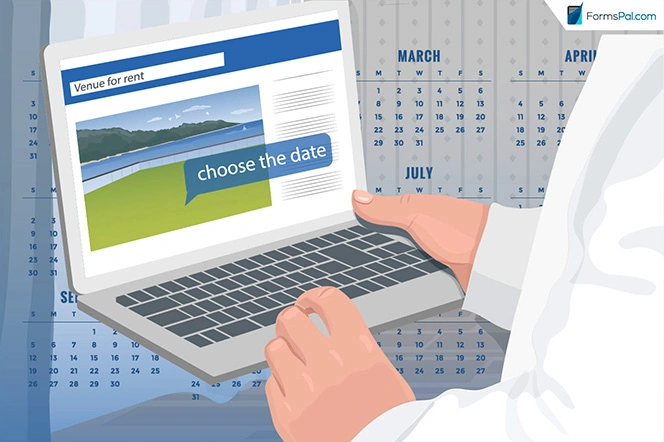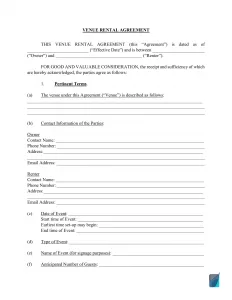Venue Rental Agreement Templates
One of the most important parts of running an event is securing the space you need for the occasion and making sure you got a good deal. Of course, venue owners also need to make sure that they are covered when it comes to event rentals so they don’t get stuck with excessive cleaning or damage costs when all is said and done.
Fortunately, a good venue rental agreement can help protect both parties. It’s important to know what these lease agreement looks like before you go in, whether you’re an owner or a renter.

Build Your Document
Answer a few simple questions to make your document in minutes
Save and Print
Save progress and finish on any device, download and print anytime
Sign and Use
Your valid, lawyer-approved document is ready
Why and When to Use a Venue Rental Agreement
Venue rental agreements are crucial, but they are also commonly overlooked by both venues and renters. A good commercial lease template outlines more than just the date and time of the event. It also covers the kinds of fees you can expect.
It’s a good idea to have a venue rental agreement for pretty much any event, from renting out space for a birthday party to hosting a professional conference and more.
A good venue rental agreement will cover details about payments, event space conditions, and more. They can be used to cover commercial properties, rental properties, and even residential space rentals for events.
Weddings should also have a venue rental, but venue wedding contracts are a separate venue renal and usually have a different agreement with their own form and different included details.
What Should be Included?
Both the owner and lessee should know what details should be included in a venue rental agreement so you can tell if you’re looking at a good rental agreement.
At a minimum, all rental agreement forms should include:
- Payment information
- Event rental dates
- Space included in the rental
- Contact information for owner and lessee
- Provisions for facility condition
- Any fees associated with damages, exceeding rental time, or other damages.
A good rental agreement form will also include:
- Consequences for late payment
- Additional venue-specific terms and fees
- Liability agreements
- Cancellation policies
- Noise Ordinances
- Included Amenities
- Included Staff or Venue Equipment
- Decor restrictions
- Vendor restrictions
- Cleanup fees and other possible extras
Fortunately, it’s possible and even recommended to use a venue rental agreement template to create a customized document for your rental property or event. You can even use a different venue rental agreement template to compare with your own and see if you’ve outlined everything you want to and have covered all the provisions and penalties you need to take care of your premises.
Venue Renting Process
Step 1: Determine How Long You Need the Rental Venue

The first step after you’ve found a venue is to determine how long you’ll need the space for your event. Most event space owners want to have as many events in their space as possible, so you’ll likely need to be as exact as possible.
It’s common to rent a venue for a single day for most events.
It’s also a good idea to rent event space for slightly longer than you need for extended events (like a business or academic conference, LARP event, or any multi-day occasion) so have a chance to clean up the event space and avoid possible fees and charges.
Step 2: Negotiate Price and Additional Rental Items

Once you know how long you need the venue, you also need to go over the price of the space rental and any additional items you would like to be included in your venue rental.
This is when you should ask questions about the event, like what kind of behavior is permissible at this venue (ie. is drinking acceptable at this location?). The lessor should also have the opportunity to ask questions about the nature and purpose of the event.
If you are asking for additional services or equipment to be included in your rental, you should document that information as well. It’s also a good idea to ask for a walk-through of the venue before the event so that you can document any pre-existing damage and verify that only items included in the rental agreement are in the space.
Step 3: Hold Your Event

The next step is relatively simple: hold your event. When it comes to most rental agreement templates, this isn’t the last step. You’ll still have to make the final payment for the venue after the event has been held.
Step 4: Pay Final Rental Cost (Including Any Additional Rental Fees)

Payment should be fairly simple, especially if you’re using a rental agreement template that includes the exact due date of all fees and the total rental cost due after the event.
Usually, the total cost due is the cost of the rental plus any additional fees accrued during the event – your security deposit (assuming no damage).
Venue Rental Agreement Form Details
| Document Name | Venue Rental Agreement Form |
| Other Names | Party Rental Contract, Event Facility Rental Agreement |
| Avg. Time to Fill Out | 20 minutes |
| # of Fillable Fields | 168 |
| Available Formats | Adobe PDF |

Filling Out a Venue Rental Agreement
Filling out a venue rental agreement, whether a custom agreement or a template, should be fairly simple. However, it’s important that you read all the details of your rental before you agree to make sure you know exactly what is expected, and so you know that you’ve filled the agreement out correctly.
Step 1: Fill Out Rental Effective Date and Renter or Owner Information
The first thing you need to fill out is the effective date and the name and information for both the renter and owners. That way you know exactly when the event will take place, and that can influence the other terms of the agreement.

Step 2: Fill Out ‘Pertinent Terms’ Information
This section is usually used to define the exact space rental included in the agreement, which areas guests are allowed to access and use, and any other details that aren’t included in the rest of the contract.

Step 3: Fill Out Contact Information
Contact information for both the renter and the owner is critical to make sure you have a means of communicating with both people in case of any hiccups or changes needed to the original contract.

Step 4: Fill Out Event Details
Event details are the other terms of your contract, including extras in the rental, and limitation. Common event details include:
- Alcohol consumption
- If a bartender is allowed, and who will provide that service
- Who will provide a liquor license
- Anticipated number of guests
- The exact time of event activities
- If an event planner will be present, and their name and contact number if applicable
- If music will be provided, by who, and what kind of music (live band, DJ, radio and CDs?)
- Food if provided, and by who
- Event setup requirements
- Decor setup and locations
- Additional Equipment Included in the rental if any
- Any equipment excluded
- Cleanup requirements and costs
- Any fees
- Location Insurance

Step 5: Cancellation Clauses, Additional Terms and Conditions, and Witnesses
A good agreement should always include cancellation clauses in case either the renter or the owner needs to back out of the agreement, or in case of an emergency that prevents the venue from being available on the date.

